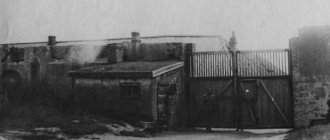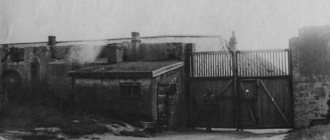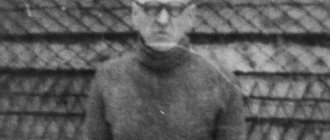Lenta.ru continues a series of publications about special regime colonies - the most terrible zones in Russia. There, the most dangerous criminals - from maniacs and cannibals to terrorists and leaders of criminal gangs - are serving life sentences there in extremely harsh conditions. In the previous article we talked about the Vologda Pyatak colony on Ognenny Island. This time we will talk about the Polar Owl colony in the village of Kharp in the Arctic Circle. In the middle of the last century, thousands of prisoners in these places died during the grandiose construction of the Transpolar Highway. Today, the Polar Owl houses especially dangerous criminals: they will spend the rest of their lives in these harsh regions, where winter seems endless, the polar night is long, and there is nowhere to run. Nevertheless, it was from the Polar Owl that for the only time in history a life-sentenced person was freed - however, not for long...
Builders of the Dead Road
In the place where today there is a special regime correctional colony No. 18 (IK-18), popularly nicknamed the “Polar Owl,” the grandiose construction of the Transpolar Highway took place in 1947-1953. There are still debates about the feasibility of laying a railway beyond the Arctic Circle. Most likely, they tried to connect Vorkuta and Norilsk by laying a railway along the coast of the polar seas for strategic reasons. After the end of World War II, the leadership of the USSR did not rule out a third - and Siberia and the Urals on the Arctic side were completely defenseless in terms of air attacks. And the Transpolar Highway in these places could become a support for a new air defense line.
Stone flower of the main prison of Russia
In Rus', “butyrka” was the name for an area separated from the main village by a forest belt. Such was the wasteland on the outskirts of Moscow in the 18th century, from which the famous prison took its name. In the northern part of the field, far from housing, the Butyrsky Castle was built in 1874. According to the plans of Catherine II, a stone prison ensemble was erected on the site of a wooden dungeon, which became the main prison in Russia.
Built according to the design of the famous architect Matvey Kazakov, Butyrka is spread over six hectares of land. The stone castle was fenced around the perimeter with four high towers with battlements. Prisoners could pray in a church built especially for them.
Butyrka in 1890. Source: wikipedia.org
Shining over the zone
In 1961, on the Sob River near the Yamal Peninsula, the closed-type settlement of Kharp (translated from Nenets as “Northern Lights”) was created by prisoners. Corrective labor colony No. 3 (ITK-3) opened on the territory of the village; The prisoners got a job at a reinforced concrete products factory that opened nearby. In May 1973, they decided to bring especially dangerous criminals from all over the USSR to ITK-3, but the idea was realized only in 1981, when 150 seasoned repeat offenders arrived in Kharp.
Polar Owl received the status of a colony for those sentenced to life imprisonment in 2004 (according to other sources, at the beginning of 2005). Among such institutions, IK-18 is considered the harshest: even nature in the village of Kharp is very unfriendly to people. In the frosty winter, during the long polar night, the only advantage of this place is the beautiful northern lights that sometimes appear over the village.
IK-18 received its informal name thanks to the sculpture of a polar owl in the prison courtyard. The choice of this bird was not accidental: firstly, it is a famous representative of the fauna of the Arctic. And secondly, in the mythology of the northern peoples, it is the owl that is the guide to the afterlife, which is very symbolic in a colony for those sentenced to life. Today, in the “Polar Owl”, designed for 1014 places, not only “lifers” are serving their sentences, but also prisoners sentenced to long terms. About 100 of the convicts live in the colony-settlement at IK-18.
Sculpture of a polar owl in the courtyard of IK-18
Shot: Vesti Yamal / YouTube
What happens after death
Where are lifers buried? In recent years, the sanitary condition of prisons has improved significantly. Therefore, the number of deaths has decreased. When a prisoner dies, relatives are informed by telegram.
If the body is not collected within three days, then burial takes place in the city cemetery. If desired, his family can rebury him later.
The conditions of detention for those sentenced to life in prison are very harsh and strict. Everything is aimed at preventing escape and reoffending.
After a few years, all relatives forget about the criminals, and the wives form new families. The only outlet for the convicted person is work or religion.
How do prisoners sentenced to life imprisonment live? Find out about it in the video:
https://youtube.com/watch?v=lQc51VAyWNw%3Fecver%3D1
Didn't find the answer to your question? Find out how to solve exactly your problem - call right now:
| Share with friends: |
Did you like the article? Follow site updates or.
Comments:
Bunk neighbors
“Polar Owl” is a completely autonomous place: it has its own power plant, boiler room, bakery, auto repair shop, poultry and pig farm, sewing production, shoe workshop, as well as factories where marble, cinder blocks and crushed stone are produced. In addition, IK-18 houses a carpentry and turning workshop, a church and even a club - although life-sentenced prisoners are not allowed there.
The number of “lifers” in the colony throughout its existence ranged from 300 to 400 people, with a limit of 464 places. Today, on the territory of the Polar Owl, they live in four two-story buildings. The cells of such prisoners are designed for 1-2 places, but when placed together, they are allowed to communicate only in a whisper. Conversations during daily walks lasting 1.5 hours are strictly prohibited - they are immediately sent to a punishment cell (punishment cell).
Stele near the village of Kharp
Photo: prisonlife.ru
By the way, jailers treat the co-location of life-sentenced prisoners with caution: potential cellmates are required to undergo an interview with a psychologist. But even those prisoners who get along well with each other sometimes change neighbors - after all, living for many years side by side with the same person often leads to conflicts. However, sometimes jailers make mistakes when selecting neighbors.
For example, in 2021, an emergency occurred in IK-18: the leader of the Combat Terrorist Organization (BTO), banned in Russia, neo-Nazi Alexei Voevodin, who was cracking down on immigrants from Africa and the Caucasus, beat his cellmate to death. And since not all premises where life-sentenced prisoners are kept are equipped with cells, the guards did not immediately realize what was going on behind the iron door and did not have time to save the prisoner.
Very dark affairs
However, in 2011, five years before the incident with Voevodin, the practice of settling Polar Owl prisoners for life in twos resulted in a major scandal. As it turned out, one of the employees of IK-18, taking advantage of his official position, in 2010 began to place a criminal collaborating with him in the cells of prisoners.
He, in turn, began to put pressure on his new neighbors: he demanded that they write confessions for crimes to which they had nothing to do. Many agreed - after all, they could not increase their life sentence anyway, and after the decoy confessed, the neighbor immediately stopped mocking them.
IK-18 “Polar Owl” in the village of Kharp
Photo: Maria Plotnikova / RIA Novosti
During the year of this vicious practice, “confessions” were extorted from almost 200 people. Among other things, the enterprising jailer managed to “uncover” the high-profile murders of Novaya Gazeta journalist Anna Politkovskaya and the editor-in-chief of the Russian edition of Forbes Paul Klebnikov. Soon, investigators began taking confessed prisoners for investigative experiments - and drew attention to inconsistencies in their testimonies. In addition, suspects began to complain about memory lapses or even tried to refuse to participate in investigative actions.
As a result, the investigation found the jailer who was behind numerous confessions. The court sentenced him to 3.5 years in prison under Article 286 (“Exceeding official powers”) of the Criminal Code of the Russian Federation. After serving his sentence, the former employee of IK-18 returned to the village of Kharp, but he never managed to get a job in the colony again. He also lost his official housing.
Life in shades of gray
The life of prisoners in the Polar Owl is subject to a strict daily routine - from getting up at 06:00 to lights out at 22:00, between which they exercise, work and walk. Convicts also have personal time when they can listen to the radio with classical music and read books. Some of the prisoners manage to get an education behind bars - for example, one of them graduated from a theological seminary in absentia.
There are no amateur performances in IK-18. But there is a TV: once a week, life-sentenced prisoners are allowed to watch DVDs on it, mostly with war films. Also, once every seven days, prisoners are entitled to a 10-minute shower - there is no bathhouse at the Polar Owl. The furnishings in the cells of convicts at IK-18 are very modest: a table, a bench, a bathroom, a water tank, a bed, a bedside table and a shelf for personal belongings and food. The colony is gradually being renovated, but only prisoners with exemplary behavior can get into the updated cells.
By the way, the “lifers” of the “Polar Owl” even have a semblance of storage rooms. Since prisoners are limited in their ability to keep all their belongings in their cells, some of them are stored in special rooms on the second floors of prison buildings. If necessary, the convicted person can contact the guards - and they will bring him what he needs from the storage room.
Reception schedule for citizens and relatives
Parcels, letters and applications are accepted on weekdays from 8 a.m. to 6 p.m. with a break from 12 p.m. to 2 p.m.
Each prisoner has the right to see relatives only once a year. Visiting hours are every Monday from 17:00 to 18:00.
Reception of citizens on an individual basis is carried out by agreement with the head or administration of the prison.
What verdict can a jury reach? Read about it in our article.
Video about the inspection of the Kharp colony:
“My hand remembers the hammer well”
Until 2015, prisoners sentenced to life in IK-18 did not have the right to work, but today the rules have changed: prisoners sew, make beads and wood carvings. However, not everyone wants to work - for example, the notorious Denis Evsyukov, a former police major. In 2009, while intoxicated, he shot visitors to the capital's Ostrov supermarket with a Makarov pistol, for which he received a life sentence. But Evsyukov is in no hurry to study sewing at Polar Owl - he says that he is not ready for this.
In general, the former policeman, who shot two people and received the nickname Bloody Major, is in good standing in IK-18, although he constantly writes complaints to various authorities. For example, Evsyukov is dissatisfied with the fact that he is sitting in the Arctic, far from Moscow. However, the enormous distance does not prevent the father of the convicted person from going on short visits with his son. But Evsyukov’s wife does not come to the Polar Owl.
Perhaps the most famous convict of IK-18 is the “Bitsevsky maniac” Alexander Pichushkin, who has 49 proven murders. His first victim was a classmate at a vocational school: an 18-year-old maniac strangled his peer and threw his body into a well. But Pichushkin became a serial killer in 2001, when he organized a real hunt for visitors to Bitsevsky Park. The victims of the maniac were both alcoholics and homeless people, as well as his acquaintances, whom Pichushkin beat with a hammer and strangled. He dumped the bodies of the dead into sewer manholes.
“Bitsevsky maniac” Alexander Pichushkin during the announcement of the verdict
Photo: Alexey Panov / RIA Novosti
After his arrest, the “Bitsevsky maniac” admitted: he wanted to kill 64 people, according to the number of squares on the chessboard. “I will return to the Bitsevsky forest. My hand remembers the hammer well,” Pichushkin shared his plans with journalists after receiving a life sentence. The first time after arriving at the Polar Owl, the maniac lived in the same cell with Nurpashi Kulaev, the only terrorist who participated in the seizure of the school in Beslan and survived. But their proximity did not last long - Kulaev began to complain about death threats from Pichushkin, and they were moved to different cells.
Nurpashi Kulaev is one of those who shot in the backs of first-graders fleeing a school building in Beslan in September 2004. As a result of the terrible terrorist attack, 333 people were killed. When the security forces launched an assault, Kulaev tried to escape and mix with the crowd, but he was identified and detained.
Nurpashi Kulaev in the hall of the Supreme Court of North Ossetia
Photo: Zaur Farniev / RIA Novosti
From Pugachev to Korolev, famous Butyrtsy
The most famous prison also hosted prisoners of appropriate status. A peasant revolt led by Emelyan Pugachev that broke out at the end of the 18th century was brutally suppressed. The rioters were shackled and thrown into damp dungeons. Emelyan Pugachev was transported to Butyrka in a cage and chained to a wall in one of the towers. Since then it has been named after him - Pugachevskaya.
In subsequent centuries, the revolutionary Nikolai Bauman, the legendary lieutenant Schmidt, the military leader Voroshilov, the founder of the Cheka Dzerzhinsky, the anarchist Makhno, the poet Osip Mandelstam, the singer Lydia Ruslanova, the actresses Zoya Fedorova and Tatyana Okunevskaya followed in Pugachev’s footsteps.
Actress Tatyana Okunevskaya. Source: wikimedia.org
The founder of the Russian cosmonautics, Sergei Korolev, was also imprisoned in Butyrka; his jaw was broken during another interrogation here. According to rumors, this is why the General Designer later died during a planned operation.
Maniacs in the ice
Kulaev’s company in IK-18 is not only Alexander Pichushkin, but also a number of other well-known serial killers. One of them is the St. Petersburg maniac Dmitry Voronenko. He showed a penchant for sadism as a child - he strangled dogs and cats for pleasure. When Voronenko grew up, people became his victims. In 2006-2007, the maniac raped and killed four St. Petersburg girls aged 11-20; As victims, he chose only miniature blondes up to 150 centimeters tall. Before identifying the serial killer, law enforcement agencies checked almost 900 people for involvement in the crimes. Relatives of the victims demanded that Voronenko be executed, despite the moratorium, but their request was rejected by the Supreme Court.
Ivan Panchenko, a maniac from Svetlograd (Stavropol Territory), received the nickname Earthen Devil - he buried one of his victims, an 8-year-old girl, alive. In addition to her, four more people died at the hands of Panchenko: a colleague with whom he deserted from the army, an 18-year-old and 16-year-old sister-in-law (the maniac kept the latter in a dug-out dugout for three years and raped him) and the 15-year-old girlfriend of the previous victim. The last victim raped by Panchenko, an 11-year-old schoolgirl, miraculously managed to survive. The Earth Devil would probably have killed the girl, but a sniffer dog picked up his trail, and in October 2008 Panchenko was detained.
Together with him in the “Polar Owl”, Abdufatto Zamanov, nicknamed Krasnoyarsk Chikatilo, is living out his life, who from 2002 to 2004 sent 14 people to the next world. Moreover, the maniac killed five victims in one day: they were residents of a garden cooperative, who, according to Zamanov, laughed at his accent, for which they were stabbed to death with a kebab skewer. His mistress, who was horrified by her partner’s revelations, helped neutralize the maniac; seizing the moment, she rushed to the police. At the trial, Zamanov argued that the victims themselves provoked him to commit crimes, which, however, did not save him from a life sentence.
Bloody count
“Belgorod Shooter” Sergei Pomazun, serving a life sentence in the Polar Owl, is behind one of the most mass murders in the history of modern Russia: six people were killed. On April 22, 2013, Pomazun broke into a gun safe belonging to his father, took a self-loading carbine and two hunting rifles from there and went to the center of Belgorod. To begin with, he looked into a gun store and shot the buyer along with two sellers who refused to release cartridges to Pomazun.
Then, on Narodny Boulevard, he shot a 14-year-old and a 16-year-old schoolgirl. The last victim of the Belgorod Shooter was a 48-year-old city dweller who was simply standing by the fountain. Pomazun was detained the day after the mass shooting. Meanwhile, some time before the tragedy, the father and mother of the future killer complained to the police about the aggressive behavior of their son, who rushed at them with a knife. But law enforcement agencies ignored these complaints.
Pomazun’s neighbor in the “Polar Owl” is former journalist and social activist Ilya Goryachev, who in 2015 was found guilty by the court of creating the “Combat Organization of Russian Nationalists” (BORN). In addition, Goryachev, according to investigators, was the ideological inspirer of the murder of lawyer Stanislav Markelov and journalist Anastasia Baburova, who were shot at the beginning of 2009 in the center of Moscow. The main witness for the prosecution was Nikita Tikhonov, the killer of Markelov and Baburova, who also received a life sentence.
Orders before 2003
Until 2003, women could be sentenced to serve their sentences under strict security conditions. Conditions in such places were created without taking into account the physiological as well as psychological needs of the female body.
After a woman served her sentence in such conditions, she became completely unsuitable for life in the wild.
Therefore, there has gradually become a need to make changes to the regime of stay of women who have committed serious crimes. Because they differ from men in physiological needs and social adaptation.
At the beginning of 2003, more than three hundred amendments were made to the PEC and the Criminal Code. With amendments in 2003, maximum security colonies for women were completely abolished. In addition, the number of visits was increased, as were the chances of being released from prison on parole.
With impeccable behavior, women have a chance to get a date outside the correctional facility.
At first, the practice of using meetings outside the zone was indeed used, but this practice quickly ceased.
Incorrigible killer
Among all Russian special regime zones, “Polar Owl” is famous for the fact that for the only time in history, a life-sentenced prisoner, 63-year-old Anvar Masalimov, was released from it. Back in 1991, a repeat offender killed an elderly resident of the village of Komsomolsk in the Tomsk region: to his misfortune, the gullible pensioner allowed Masalimov to live with him, despite the fact that Anvar had just been released after serving time for murder.
During the next feast, the guest strangled the hospitable host, after which Masalimov tried to cover his tracks. He dismembered the body of the deceased, burned his head in the stove, and threw the other remains into the street toilet. The neighbor decided to use it - and made a terrible discovery.
IK-18 “Polar Owl” in the village of Kharp
Photo: prisonlife.ru
For his crime, Masalimov was sentenced to death, but in 1996 it was commuted to life imprisonment. Once in the zone, the convict immediately began writing complaints to all possible authorities - and in 1998 he achieved his goal: his article was reclassified to a more lenient one. True, at that time Masalimov’s term did not change.
However, the mitigation of the article played a role when 25 years had passed since the beginning of the convict’s term and he received the right to parole. At the beginning of 2021, the court released Masalimov with the wording “in connection with the adoption of a law improving the situation of the convicted person.” As soon as the former prisoner was released, his traces were lost, but not for long. Masalimov quickly returned to drinking alcohol and got involved in a domestic fight in Ufa. According to investigators, Anwar quarreled with his drinking companion and stabbed him in the stomach. As a result, the victim was hospitalized, and Masalimov was sent to a pre-trial detention center.











